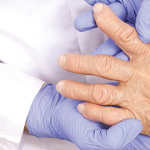The MSOA paper also may have been influenced by selection bias, “as only highly motivated individuals” who sought out the intervention were enrolled.
What’s Next
Prof. van Schaardenburg’s team is working on additional research to build on the trials. They expect to complete the two-year extension study this year and are launching a study examining why and how patients in the trials manifested better results than the control groups. The researchers are trying to see “how the changes in the food reflect changes happening in the gut with the bacteria residing there and how the interaction with the immune system is,” Prof. van Schaardenburg says. They are also planning for a phase 4 cohort study to test the original intervention in clinical practices.
The team shared results from the first year of the extension study at the European Congress of Rheumatology in June 2023. They found the 47 participants who completed the MSOA follow-up had a greater average change in total WOMAC score (–11.4 vs. –11.0) and weight (–5.3 vs. –3.7 kg) than those who did not finish, but showed less improvement in HbA1c (–2.1 vs. –2.9 mmol/mol). The total WOMAC score (–8.8) and individual WOMAC marks remained significantly improved compared with scores before participants started the program, except for stiffness. Weight stayed down as well. Of the 24 participants using pain medication at baseline, 11 decreased their dosages or stopped taking at least one drug.
Researchers also found the 65 participants who completed the rheumatoid arthritis follow-up showed a greater average decline in their total DAS28 score (0.9 vs. 0.05) than those who did not finish. They manifested a mean 1.01-point total DAS28 difference compared with baseline (95% CI 0.76–1.26; P<0.001), 45 patients showed better DAS28 scores with the same amount or less medication, and all facets of the DAS28 improved significantly. Of the 61 participants using anti-rheumatic medication at baseline, 27 decreased their dosages or stopped taking at least one medication. Weight did not show a significant difference.
“That’s great,” Dr. Sammut says of participants sustaining many of their positive results after the trial period. “We managed to maintain the results in the year after without them following the program anymore, so they had to do it on their own. They had some webinars and some newsletters to keep them on track. But they had to do it mostly by themselves, and then they did,” Prof. van Schaardenburg says.


